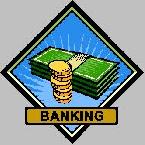
 |
|
| Financial Terms | |
| Wallflower |
|
Information about financial, finance, business, accounting, payroll, inventory, investment, money, inventory control, stock trading, financial advisor, tax advisor, credit.
Main Page: investment, financial, accounting, finance, inventory control, credit, inventory, financial advisor, |
Definition of Wallflower
WallflowerStock that has fallen out of favor with investors; tends to have a low P/E (price to earnings ratio).
Related Terms:NPV (net present value of cash flows)Same as PV, but usually includes a subtraction for an initial cash outlay. PV (present value of cash flows)the value in today’s dollars of cash flows that occur in different time periods. Accounting earningsearnings of a firm as reported on its income statement. Acid-test ratioAlso called the quick ratio, the ratio of current assets minus inventories, accruals, and prepaid Acquisition of stockA merger or consolidation in which an acquirer purchases the acquiree's Stock. Adjustable rate preferred stock (ARPS)Publicly traded issues that may be collateralized by mortgages and MBSs. American Stock Exchange (AMEX)The second-largest Stock exchange in the United States. It trades  Appraisal ratioThe signal-to-noise ratio of an analyst's forecasts. The ratio of alpha to residual standard Arm's length priceThe price at which a willing buyer and a willing unrelated seller would freely agree to Articles of incorporationLegal document establishing a corporation and its structure and purpose. Ask priceA dealer's price to sell a security; also called the offer price. Asset/equity ratioThe ratio of total assets to Stockholder equity. Asset activity ratiosratios that measure how effectively the firm is managing its assets. Auction rate preferred stock (ARPS)Floating rate preferred Stock, the dividend on which is adjusted every Bargain-purchase-price optionGives the lessee the option to purchase the asset at a price below fair market Basis priceprice expressed in terms of yield to maturity or annual rate of return.  Beta equation (Stocks)The beta of a Stock is determined as follows: Bid priceThis is the quoted bid, or the highest price an investor is willing to pay to buy a security. Practically Blow-off topA steep and rapid increase in price followed by a steep and rapid drop. This is an indicator seen Borrower falloutIn the mortgage pipeline, the risk that prospective borrowers of loans committed to be BreakoutA rise in a security's price above a resistance level (commonly its previous high price) or drop BuyoutPurchase of a controlling interest (or percent of shares) of a company's Stock. A leveraged buy-out is Call priceThe price, specified at issuance, at which the issuer of a bond may retire part of the bond at a Call priceThe price for which a bond can be repaid before maturity under a call provision. Capital rationingPlacing one or more limits on the amount of new investment undertaken by a firm, either Capitalization ratiosAlso called financial leverage ratios, these ratios compare debt to total capitalization Cash flowIn investments, it represents earnings before depreciation , amortization and non-cash charges.  Cash flow after interest and taxesNet income plus depreciation. Cash flow coverage ratioThe number of times that financial obligations (for interest, principal payments, Cash flow from operationsA firm's net cash inflow resulting directly from its regular operations Cash flow matchingAlso called dedicating a portfolio, this is an alternative to multiperiod immunization in Cash flow per common shareCash flow from operations minus preferred Stock dividends, divided by the Cash flow time-lineLine depicting the operating activities and cash flows for a firm over a particular period. Cash-flow break-even pointThe point below which the firm will need either to obtain additional financing Cash ratioThe proportion of a firm's assets held as cash. CashoutRefers to a situation where a firm runs out of cash and cannot readily sell marketable securities. Clean priceBond price excluding accrued interest. Closing purchaseA transaction in which the purchaser's intention is to reduce or eliminate a short position in Common stockThese are securities that represent equity ownership in a company. Common shares let an Common stock/other equityValue of outstanding common shares at par, plus accumulated retained Common stock equivalentA convertible security that is traded like an equity issue because the optioned Common stock marketThe market for trading equities, not including preferred Stock. Common stock ratiosratios that are designed to measure the relative claims of Stockholders to earnings Concentration accountA single centralized account into which funds collected at regional locations Concentration servicesMovement of cash from different lockbox locations into a single concentration Conflict between bondholders and stockholdersThese two groups may have interests in a corporation that Consumer Price Index (CPI)The CPI, as it is called, measures the prices of consumer goods and services and is a Controlled foreign corporation (CFC)A foreign corporation whose voting Stock is more than 50% owned Conversion parity priceRelated:Market conversion price Convertible priceThe contractually specified price per share at which a convertible security can be Conversion ratioThe number of shares of common Stock that the security holder will receive from Convertible exchangeable preferred stockConvertible preferred Stock that may be exchanged, at the Convertible preferred stockPreferred Stock that can be converted into common Stock at the option of the holder. CorporationA legal "person" that is separate and distinct from its owners. A corporation is allowed to own Cost-benefit ratioThe net present value of an investment divided by the investment's initial cost. Also called Coverage ratiosratios used to test the adequacy of cash flows generated through earnings for purposes of Cumulative preferred stockPreferred Stock whose dividends accrue, should the issuer not make timely Current ratioIndicator of short-term debt paying ability. Determined by dividing current assets by current Customary payout ratiosA range of payout ratios that is typical based on an analysis of comparable firms. Days' sales in inventory ratioThe average number of days' worth of sales that is held in inventory. Days' sales outstandingAverage collection period. Debt/equity ratioIndicator of financial leverage. Compares assets provided by creditors to assets provided Debt ratioTotal debt divided by total assets. Debt-service coverage ratioearnings before interest and income taxes plus one-third rental charges, divided Declaration dateThe date on which a firm's directors meet and announce the date and amount of the next Delivery priceThe price fixed by the Clearing house at which deliveries on futures are in invoiced; also the Devaluation A decrease in the spot price of the currency
Direct stock-purchase programsThe purchase by investors of securities directly from the issuer. Dirty priceBond price including accrued interest, i.e., the price paid by the bond buyer. Discounted cash flow (DCF)Future cash flows multiplied by discount factors to obtain present values. Discretionary cash flowCash flow that is available after the funding of all positive NPV capital investment Dividend payout ratioPercentage of earnings paid out as dividends. Dividend yield (Stocks)Indicated yield represents annual dividends divided by current Stock price. Dollar durationThe product of modified duration and the initial price. Dollar price of a bondPercentage of face value at which a bond is quoted. Domestic International Sales Corporation (DISC)A U.S. corporation that receives a tax incentive for Down-and-out optionBarrier option that expires if asset price hits a barrier. DurationA common gauge of the price sensitivity of an asset or portfolio to a change in interest rates. EarningsNet income for the company during the period. Earnings before interest and taxes (EBIT)A financial measure defined as revenues less cost of goods sold Earnings per share (EPS)EPS, as it is called, is a company's profit divided by its number of outstanding Earnings retention ratioPlowback rate. Earnings surprisesPositive or negative differences from the consensus forecast of earnings by institutions Earnings yieldThe ratio of earnings per share after allowing for tax and interest payments on fixed interest Economic earningsThe real flow of cash that a firm could pay out forever in the absence of any change in Edge corporationsSpecialized banking institutions, authorized and chartered by the Federal Reserve Board Effective call priceThe strike price in an optional redemption provision plus the accrued interest to the Effective durationThe duration calculated using the approximate duration formula for a bond with an Employee stock fundA firm-sponsored program that enables employees to purchase shares of the firm's Employee stock ownership plan (ESOP)A company contributes to a trust fund that buys Stock on behalf of Equilibrium market price of riskThe slope of the capital market line (CML). Since the CML represents the Equivalent annual cash flowAnnuity with the same net present value as the company's proposed investment. Exchange of stockAcquisition of another company by purchase of its Stock in exchange for cash or shares. Exercise priceThe price at which the underlying future or options contract may be bought or sold. Expected future cash flowsProjected future cash flows associated with an asset of decision. Expense ratioThe percentage of the assets that were spent to run a mutual fund (as of the last annual ExpirationThe time when the option contract ceases to exist (expires). Expiration cycleAn expiration cycle relates to the dates on which options on a particular security expire. A Expiration dateThe last day (in the case of American-style) or the only day (in the case of European-style) Fair market priceAmount at which an asset would change hands between two parties, both having Related to : financial, finance, business, accounting, payroll, inventory, investment, money, inventory control, stock trading, financial advisor, tax advisor, credit. |